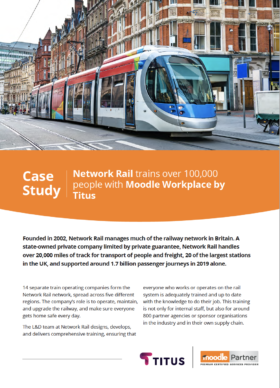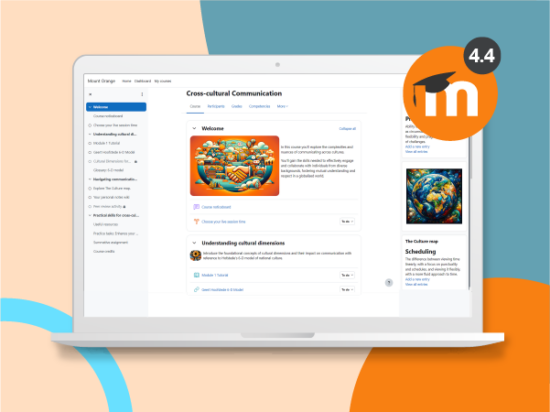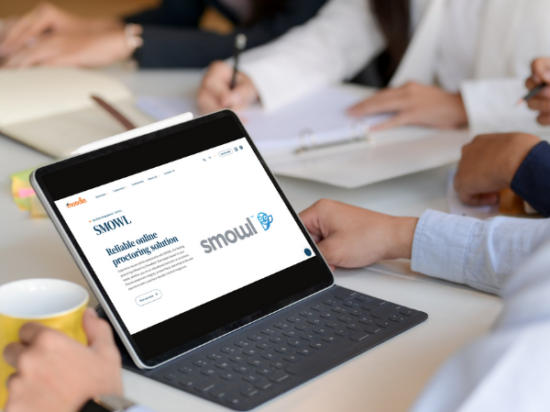Founded in 2002, Network Rail manages much of the railway network in Britain. A state-owned private company limited by private guarantee, Network Rail handles over 20,000 miles of track for transport of people and freight and 20 of the largest stations in the UK, and supported around 1.7 billion passenger journeys in 2019 alone.
14 separate train operating companies form the Network Rail network spread across five different regions. The company’s role is to operate, maintain, and upgrade the railway, and make sure everyone gets home safe every day.
The L&D team at Network Rail designs, develops, and delivers comprehensive training, ensuring that everyone who works or operates on the rail system is adequately trained and up to date with the knowledge to do their job. This training is not only for internal staff, but also for around 800 partner agencies or sponsor organisations in the industry and in their own supply chain.
Challenge
Managing several virtual learning environments
Previously Network Rail was using 10 different virtual learning environment installations. This dispersed management of content creation and distribution, as well as the administration of the sites and learners was very challenging and time-consuming for the L&D team.
Tracking and monitoring users
One of the challenges Network Rail came across was identifying which of the users on each of their learning environments were active or inactive. On one hand, there were up to as many as 300,000 users, but no way of identifying if they simply opened accounts and had not enrolled themselves in any training courses, or had enrolled into courses but not completed them. On the other hand, it was cumbersome for the training team to obtain reports and data across the industry, as learners were scattered in several learning environments that were not connected to each other. This also meant that if Network Rail wanted to move a learner from one learning environment to the other, they’d lose all their learning records.
Integrating with external systems
Besides the multiple learning environments used to train their staff and partner companies, Network Rail used different systems in-house to manage their people, onboard new employees and handle employees who were leaving. These systems did not integrate with their learning environments, which interfered with automating processes. As part of their opportunity to grow in the number of products and recover some of the cost of creating eLearning products (which fell on taxpayers) Network Rail wanted to integrate their virtual learning environment with an eCommerce solution to monetise some of their external training.
Improving the learning culture
Finally, there was also a matter of the learning culture at Network Rail. The way in which their learning was organised made it difficult to create learning paths or groupings of courses for users to follow, and the organisation was struggling to meet learning objectives. Moreover, when they moved a learner from one platform to another, all learner records and data were lost, making it impossible to track the learning journey of their users.
Solution
Moodle Workplace: making the most of multi-tenancy
After a tender process where they analysed several different training solutions, Network Rail awarded their eLearning project to Certified Premium Moodle Partner Titus, who had submitted a proposal based on Moodle Workplace.
Titus’s solution delivered a GDPR compliant learning management system that allowed Network Rail to create multiple sub-platforms for each organisation within their supply chain and network – all managed centrally from a single installation.
A platform that grows with the organisation
In order to accommodate the number of users Network Rail would need to train, the company worked with Titus to build a custom server within a cloud service. Going down this road meant Network Rail had a platform that could easily scale and handle the daily increase in the number of users training with them.
Delegating eLearning to local teams
Moodle Workplace’s multi-tenancy enabled Network Rail to create a sub-platform for each of the organisations that operate under them, as well as one for the internal staff. All the sub platforms, or tenants, are managed centrally and allow Network Rail to easily deploy content in all of them, while also making sure that the content is always updated in each sub-site.
Thanks to the customisable user roles in Moodle Workplace, Titus was able to create new user roles within Network Rail’s learning sub-platforms with different capabilities and access privileges, so that Network Rail could delegate the day-to-day management of learning and development to local teams.
Mirroring the organisational structure
Network Rail set up their Moodle Workplace to replicate their company structure, so that line managers and team leads would be able to view, monitor and access reports on the learning journey of the employees who reported to them, taking ownership of their progress and performance.
Powerful reporting to make data-driven decisions
Using Moodle Workplace’s built-in reporting tools, the team at Network Rail is able to generate comprehensive reports on every aspect of how the platform is used, from enrolment, to course completion, to achieved learning outcomes. This allows them to identify and eliminate waste at every stage of the process, and support decisions with real-time data.
Because all sub platforms or tenants are in the same Moodle Workplace learning environment, Network Rail can also move people safely from one sub-platform to another without losing any of their data or learning records.
Additionally, Titus added the Intelliboard reporting tool to Moodle Workplace, to allow sponsor managers and training managers to easily build their own reports and keep on top of what’s going on in the platform.
Seamless integration with the ERP
Network Rail’s own tenant within their new learning environment integrates with the company’s ERP (Enterprise Resource Planning Software), where they manage all their staff information and all the competences every position needs to have. Now, when Network Rail onboard a new team member, an account is automatically created for them in Moodle Workplace – and any employee leaving the organisation has their account automatically closed too.
Learning programs to meet company goals
With Moodle Workplace, Network Rail are now building learning paths for their staff and for external providers, with different programs for each of their roles. These learning paths are groupings of courses where learners are automatically enrolled to the next course after completing one. This ensures that everyone is up-to-date with compliance and that Network Rail are on track to achieving the company’s learning goals.
Results
The platform contains several sub-platforms for each of their partner organisations, so Network Rail can delegate administrative tasks and focus on creating more learning products.
The reporting tools built into the system enable Network Rail to make data-driven decisions on how the platform should be used, streamlining the training process as a whole.
With Moodle Workplace, Network Rail now has a single learning platform unifying content creation and distribution, payment handling, analysis and reporting for up to 100,000 users.
Learn more about Titus on their Certified Service Provider page.
Want to try Moodle Workplace? Book a demo with our team today.




